Lavender makes a soap relaxing yet delightful. Melt and pour soap bases are an excellent way to make your own lavender soap. Today I am sharing an easy homemade soap recipe that uses a melt and pour soap base instead of you having to make cold process soap – so no lye is involved. It is perfect for beginners wanting to get into soap making but not deal with a lye solution.
pin this for later! 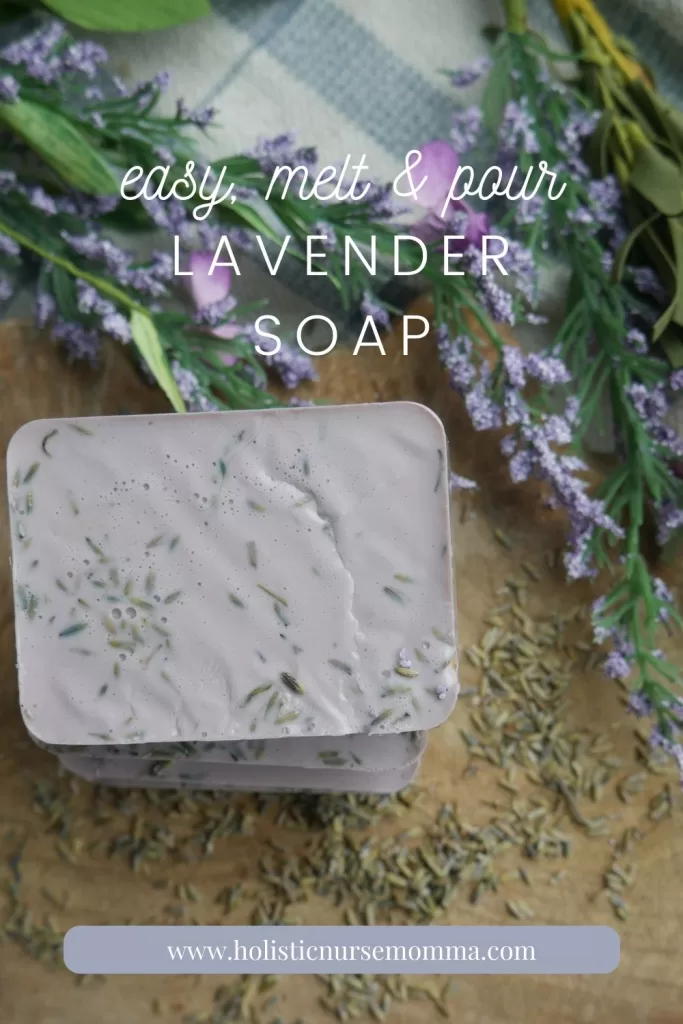
These lovely homemade soap bars are great as a gift for Mother’s Day or a stocking stuffing! You could add some homemade sugar scrub and body butter to gift basket or box, then give homemade gifts to your loved ones for special occasions.
Lavender soap benefits
This lavender melt and pour soap recipe is a great way to customize your bar of soap as you please. Lavender flowers are known for their calming effect. The scent they release reduces stress and anxiety, leads to better sleep, and improves skin health. When used topically (on the skin), lavender also soothes irritations and rashes. This is why it is a popular ingredient in skincare products and tends to be well tolerated by most skin types.
What are melt and pour bases?
To create melt and pour bases, soap makers have already completed the saponification process, resulting in a ready-to-use soap block. To create handmade lavender soap, you can easily melt soap bases, add your essential oils & colors, then pour the melted soap base into silicone molds to be be used or cut later.
There are different types of melt and pour bases and, with the help of natural ingredients, they each can serve various purposes for different skin types. Here are some main differences in the soap bases I’ve used:
- goat milk base: this base tends to be good for all skin types, to include sensitive skin, and helps to moisten dry skin and is rich in vitamins and minerals
- shea butter base: this is also deeply moisturizing and helps to protect the skin barrier
- glycerin base: great for those looking for a clear soap base that has no to minimal scent but is also a gentle cleanser
- oatmeal base: gently exfoliating, helps to sooth skin inflammation, and it’s anti-oxidant rich, meaning it will bind to free radicals to help prevent the aging of skin
- honey base: has wound healing properties (so good for small cuts, eczema, etc), is naturally anti-bacterial, and a draws moisture into the skin
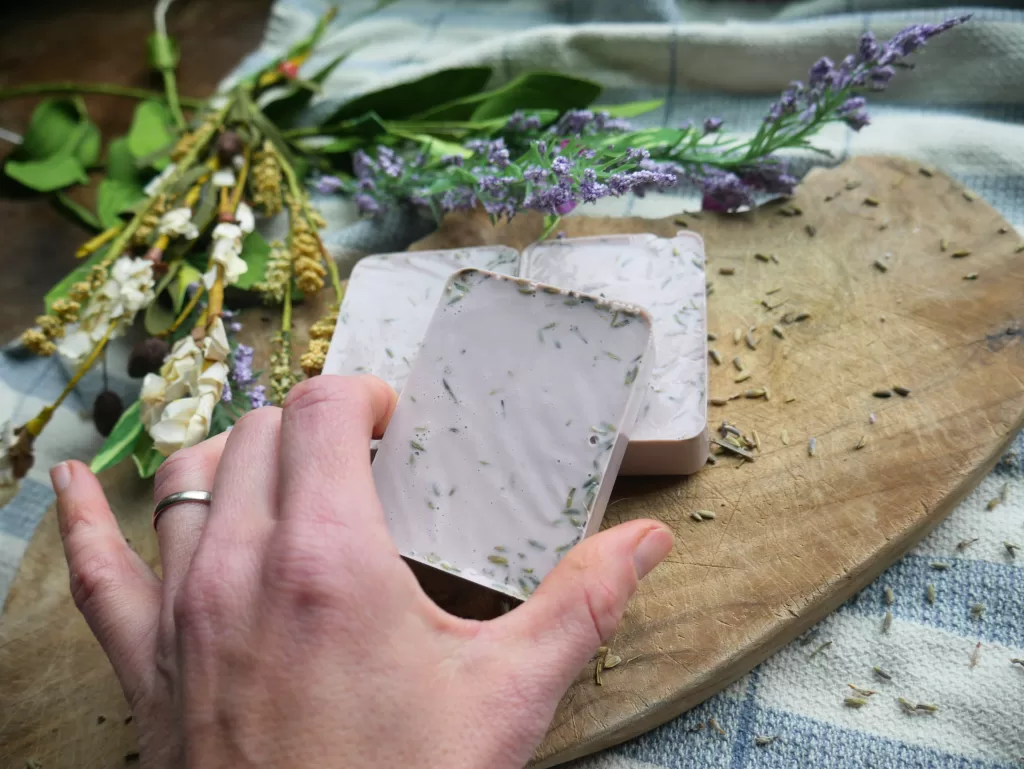
Essential oil blends to consider
Keep in mind, the amount of essential oil will affect how strongly your soap smells, but you also want to ensure they mix well with your soap mixture so they are not too concentrated in one area of the soap. You can also buy an already mixed essential oil blend (I love the blends from Eden’s Garden). If you are wanting more than lavender in your lavender soap, these are some wonderful essential oils to blend with it:
- lemon lavender soap
- chamomile lavender soap
- peppermint, lemon, & lavender soap
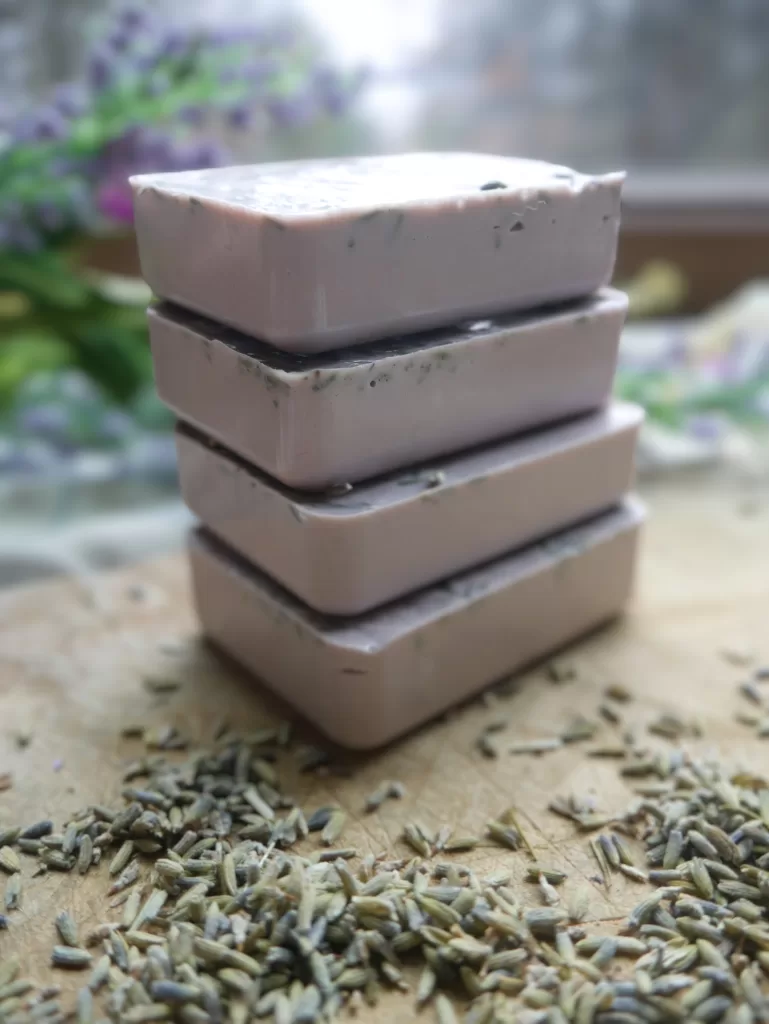
FAQs
Help! My soap has air bubbles
This took some trial and error on my part. The best way I have found to avoid air bubbles is, once I get the water to a boil in my large pot, to then turn the heat down to medium high or medium low heat. This will decrease the amount of stirring time too which can increase bubbles in your finished product.
Another method I have read on the internet is to have a spray bottle with isopropyl alcohol (the type you find in the band aid aisle) and lightly mist the bubbles if you see them forming. I have not given this option a go, but it makes sense to me as the alcohol would burn off and keeping it light should not affect your handmade soap.
How do I make my own double boiler?
To set up a double boiler, fill a pot with water. Then, add a smaller pot inside OR a large glass bowl over top. This will allow the boiling water to heat up the smaller pot or glass bowl so the heat is not as intense and will not burn or scorch your natural soap.
If you do not have a way to make a double boiler, you could try heating and melting your soap in the microwave in a glass bowl by heating it up for short intervals, although I have never tried this way.
Are melt and pour bases natural?
There are different brands and types of melt and pour bases, so be sure to check the ingredients. I enjoy using Our Earth’s Secret bases.
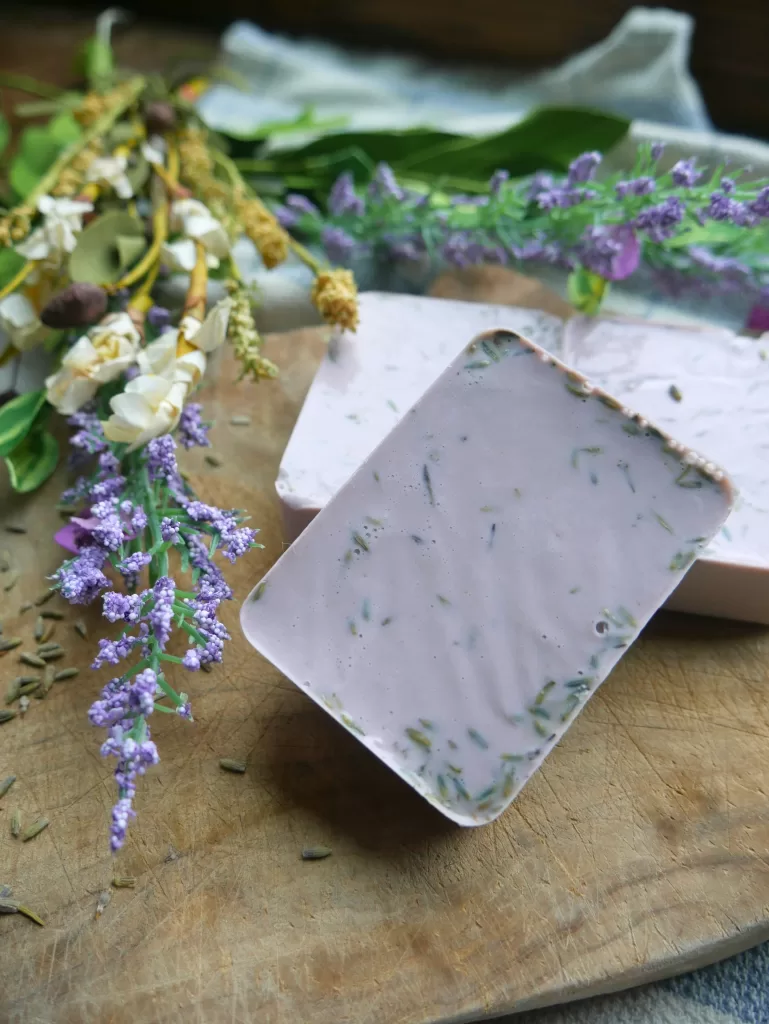
Can I use food dye in my melt and pour lavender soap?
You could try, but keep in mind that food dye will may not disperse well and may stain your skin. It might be better to stick to the colorants I mention in the post.
When can I use my melt and pour soap?
As soon as it has hardened! If you allow it to sit for a couple days, it could improve its longevity and hardness though.
Are melt and pour soap bases okay for sensitive skin?
Always check the ingredients on soap bases before buying them, especially if you have know allergies or sensitivities. As mentioned above, there are different soap bases used for different reasons.
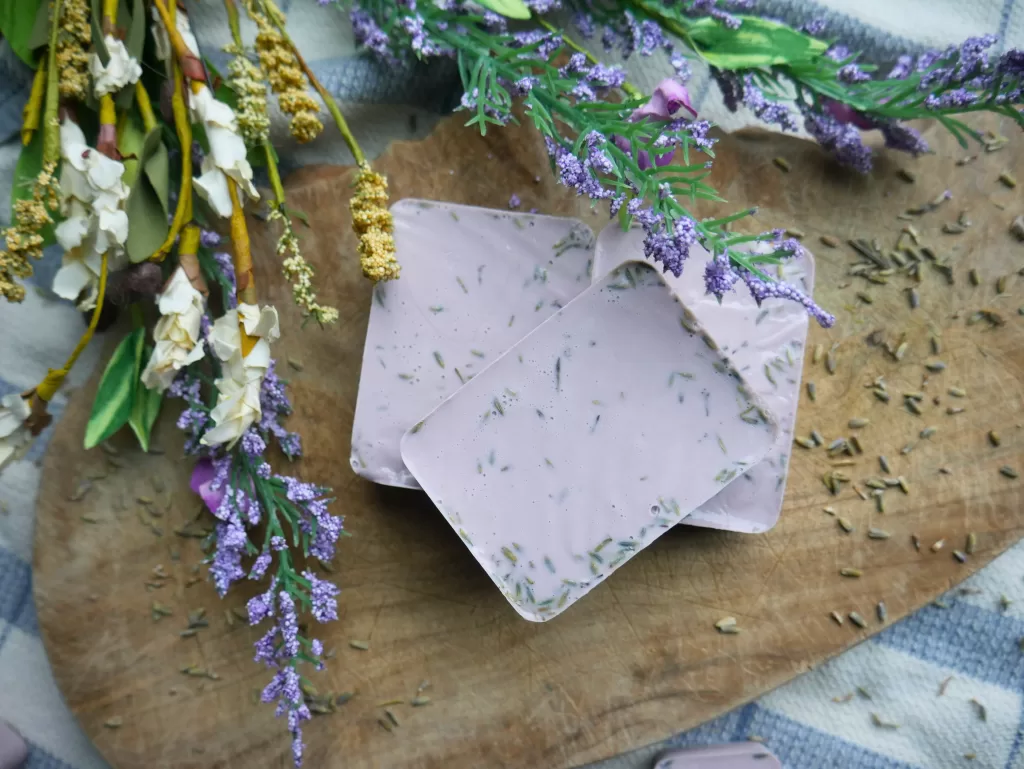
nifty tools to have so you can make homemade lavender soap
- Double boiler set up
- Melt and pour soap base
- Soap mold (either one large one to cut into smaller bars of soap later or a soap mold that makes individual soaps)
- Essential oils
- Purple Color, optional (Dyes, purple brazilian clay, or alkanet root powder are great choices)
- Lavender essential oil or lavender fragrance oil
How to make this DIY lavender soap recipe
All you have to do is follow these easy steps for the melt and pour method of soap making!
- Set up your double boiler method to get the water boiling.
- Cut ½ pound soap base into equal sized chunks
- Turn the heat down to medium heat.
- Add to your small pot or large glass bowl to melt the base.
- Once completely melted, add about 30-40 drops of lavender essential oil (or a total of 30-40 if doing a DIY blend).
- Quickly pour your melted soap into your soap mold or molds.
- If you are wanting to add dried lavender buds, press them into the top of the soap before being allowed to harden.
- Allow to sit for 24 hours before pushing out of the mold to use or cut into soap bars.
- Enjoy your homemade lavender oil soap!!
check out my other easy soap recipes to make your own soap!
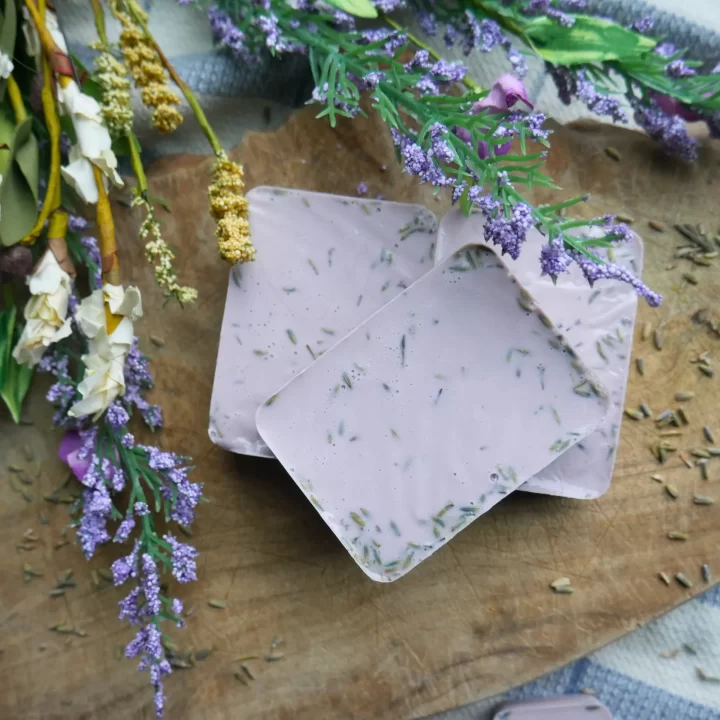
Easy Homemade Lavender Soap (melt & pour)
This lovely DIY lavender soap smells wonderful and promotes relaxtion. When uses on the skin, lavender helps to decrease skin irritations.
Materials
- ½ pound melt and pour soap base
- 30-40 drops of essential oils
- dried lavender (optional)
Tools
- double boiler
- soap mold
Instructions
- Set up your double boiler method to get the water boiling.
- Cut ½ pound soap base into equal sized chunks
- Turn the heat down to medium heat.
- Add to your small pot or large glass bowl to melt the base.
- Once completely melted, add about 30-40 drops of lavender essential oil (or a total of 30-40 if doing a DIY blend).
- Quickly pour your melted soap into your soap mold or molds.
- (optional) If you are wanting to add dried lavender buds, press them into the top of the soap before being allowed to harden.
- Allow to sit for 24 hours before pushing out of the mold to use or cut into soap bars.
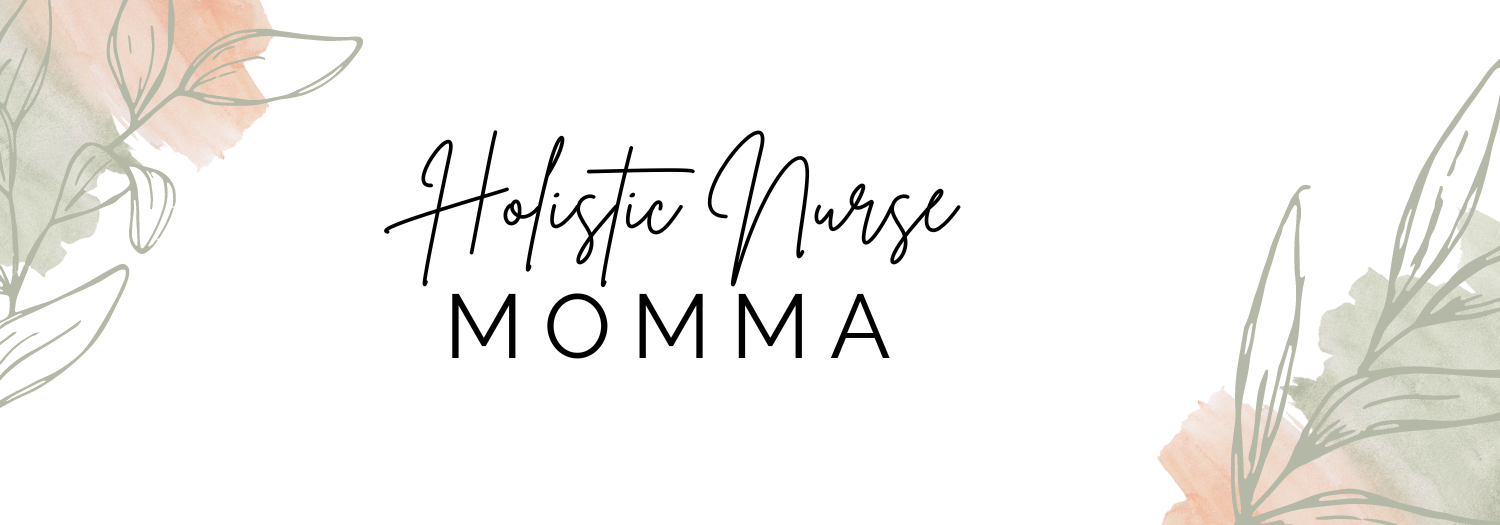
Leave a Reply